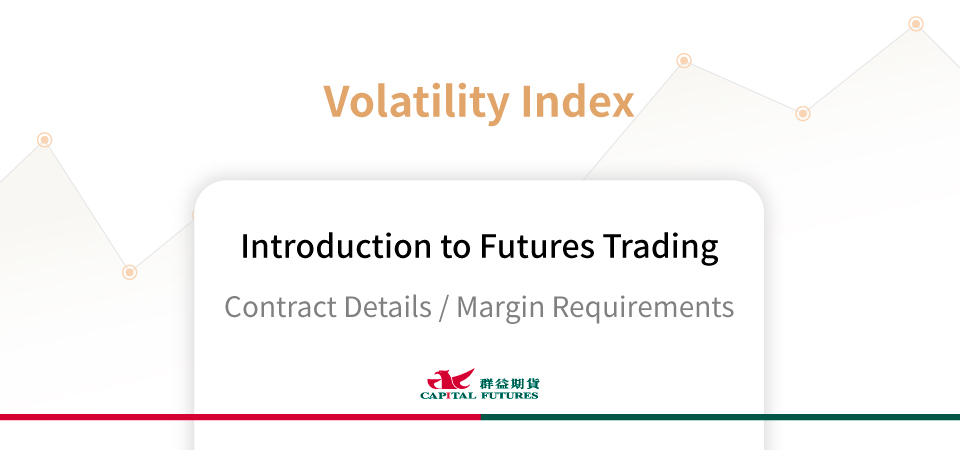Volatility Index Futures Margin & Contract Specifications

What is the Volatility Index (VIX)?
The Volatility Index (VIX), also known as the "Fear Index," is a market volatility indicator compiled by the Chicago Board Options Exchange (CBOE). It measures investors’ expectations of volatility in the U.S. stock market (S&P 500 Index) over the next 30 days.
The VIX is derived from the implied volatility of S&P 500 index options. A higher value indicates greater expected market risk and volatility. Since the VIX typically rises during periods of market panic and falls during stable conditions, it is regarded as a key gauge of market sentiment.
Functions and Features of VIX Futures (VX)
VIX Futures (VX) track expected future volatility of the VIX index. They allow investors to position or hedge against anticipated market risk or panic. Key features include:
1. Hedging and Speculation Capabilities
VX tends to have a negative correlation with the S&P 500 Index. When the stock market experiences sharp declines, the VIX usually spikes. Through VIX futures, investors can hedge against extreme market volatility or position ahead of potential market turmoil, offering high strategic flexibility.
2. Different from Spot VIX – Term Structure
The price of VX futures does not necessarily equal the current spot VIX value. Instead, it reflects expectations of future volatility and often shows contango (premium) or backwardation (discount). Investors must understand the structural differences and time-value characteristics between the futures and the spot index.
3. High Volatility with Diverse Strategy Applications
VX is a highly volatile asset with sharp price fluctuations. It is suitable for professional investors engaging in arbitrage, calendar spreads, event-driven trades, or hedging in combination with U.S. equity ETFs and futures.
4. Monthly Settlement
VX futures settle on the third Wednesday of each month and are cash-settled contracts. This allows investors to participate without holding the underlying asset, making them convenient for short- to medium-term risk management and strategy deployment.
Exchange
CBOE Futures Exchange (CFE)
Key Factors Influencing VIX Futures (VX)
1. U.S. Stock Market Volatility and Major Financial Events
Since VX is inversely correlated with the S&P 500, sharp equity declines or sudden political/financial risks drive hedging demand, pushing volatility higher. Conversely, when the stock market is stable or rising, the VIX tends to decline.
2. FOMC Meetings and Interest Rate Policies
Federal Reserve interest rate decisions, meeting statements, and Chair Powell’s remarks may alter market expectations, trigger capital flows, and increase volatility—impacting VX pricing.
3. Corporate Earnings Season and Key Economic Data Releases
Events such as Non-Farm Payrolls, CPI, PCE, GDP data releases, as well as earnings reports from major tech companies like Apple, NVIDIA, and Tesla, often raise uncertainty and lift VX futures.
4. Global Systemic Risks and Geopolitical Events
Black swan events such as pandemic resurgences, U.S.–China trade tensions, escalation of the Russia–Ukraine war, or major debt defaults may heighten market panic, potentially driving VX futures sharply higher.
5. VX Futures Curve and Investor Sentiment
The contango/backwardation structure of VX futures reflects market pricing of future risks. If near-term contracts trade above longer-term ones (backwardation), it often signals heightened panic. Conversely, contango typically reflects a calmer, more bullish market outlook.
CBOE Volatility Index Futures Margin
How much money is needed to trade futures? At the beginning, the required margin is the initial margin. While holding a position, the margin after deducting floating profits and losses must remain above the maintenance margin; otherwise, a margin call will be issued. For day-trading margin, only half of the margin is required, provided the position is closed before the market closes.
Foreign Futures
| Name | Code | Initial Margin | Approximate Cost in TWD | Maintenance Margin | Day Trading Margin |
|---|---|---|---|---|---|
| CBOE Volatility Index Futures | VX | USD 7,733 | 237,403 | USD 7,030 | USD 3,867 |
CBOE Volatility Index Futures Contract Specifications
Here is a summary for traders of the contract specifications, exchange, trading hours, minimum price fluctuation, and available trading months for CBOE Volatility Index FuturesFutures.
| Name/Code | $ CBOE Volatility Index FuturesVX |
|---|---|
| Exchange | Cboe Futures Exchange |
| Category | Futures |
| Local Trading Hours |
06:00~05:00 |
| Contract Specifications | USD 1,000 |
| Minimum Price Fluctuation | 0.05 points = 50 USD |
| Trading Months | 9 consecutive months |
CBOE Volatility Index FuturesLast Trading Day
Futures
| Commodity | Jan | Feb | Mar | Apr | May | Jun | Jul | Aug | Sep | Oct | Nov | Dec | |
|---|---|---|---|---|---|---|---|---|---|---|---|---|---|
| CBOE Volatility Index Futures (VX) | First Notice Day | 01/22 | 02/19 | 03/18 | 04/16 | 05/21 | 06/18 | 07/16 | 08/20 | 09/17 | 10/22 | 11/19 | 12/17 |
| Last Trading Day | 01/22 | 02/19 | 03/18 | 04/16 | 05/21 | 06/18 | 07/16 | 08/20 | 09/17 | 10/22 | 11/19 | 12/17 | |




